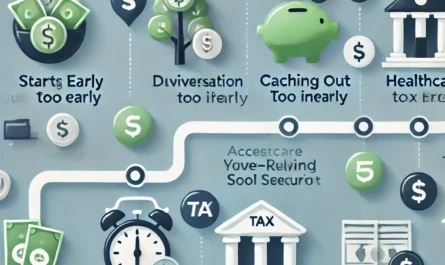Retirement is one of life’s most significant transitions, and preparing for it thoroughly can help ensure that the shift is both smooth and enjoyable. The key to transitioning from full-time work to retirement lies in strategic planning, mental preparedness, and flexibility. It’s about embracing change, taking control of your future, and making the most of your newfound freedom. Whether it’s financial readiness, emotional adjustment, or lifestyle changes, a holistic approach is essential for success.
Understanding the Importance of Planning
A successful retirement begins years, or even decades, before your last day of work. Planning ahead gives you control over the lifestyle you wish to lead once you step away from the workforce. The earlier you start preparing, the more options you’ll have when the time comes. Consider both the practical and emotional sides of the equation. What will your daily life look like? Where will your income come from? How will you maintain your sense of purpose? Answering these questions early will help make your transition smoother.
Financial Preparations for Retirement
One of the most critical factors in ensuring a smooth transition to retirement is solid financial preparation. This is where budgeting, saving, and investing come into play.
Creating a budget tailored to retirement can prevent financial stress later on. Consider how your expenses may shift: while you may no longer be commuting, you may spend more on health care or leisure activities. To anticipate these changes, track your current spending and estimate future needs. Building a retirement fund early on, and managing it well, can make a world of difference.
You’ll also need to understand your investment options. Having a diversified portfolio—one that includes bonds, stocks, and other assets—will help protect against inflation while ensuring that your retirement savings last throughout your lifetime.
Assessing Your Retirement Goals
A key part of a smooth transition is knowing what you want from your retirement years. This involves identifying both your personal and financial goals. Do you want to travel the world? Or maybe you’re looking forward to spending more time with family and grandchildren. By defining what’s most important to you, you can allocate your resources and time accordingly.
Financial goals are equally essential. Decide how much money you need to live the life you want, and prioritize accordingly. It’s important to balance your desires with practical considerations to avoid running out of funds too early.
Creating a Flexible Retirement Plan
Flexibility is another important element of a smooth transition to retirement. Life rarely goes according to plan, and retirement is no exception. Unforeseen expenses, health issues, or changes in family circumstances can arise. Therefore, it’s essential to craft a retirement plan that can adapt to changing conditions.
Some people choose to ease into retirement by gradually reducing their working hours. This phased approach allows you to adjust to life without a full-time job while continuing to earn money. Moreover, it can provide an opportunity to test the waters and see what works best for you.
Emotional Aspects of Retirement
Beyond financial concerns, the emotional impact of retiring can be significant. Work often provides structure, routine, and a sense of identity. Stepping away from this environment can feel like a loss, leading to feelings of isolation or uncertainty. That’s why it’s crucial to prepare mentally for the transition.
Coping with the emotional aspects of retirement involves staying engaged with hobbies, interests, and social activities. Many retirees find joy in pursuing long-forgotten passions, learning new skills, or becoming more involved in their communities. The key is to maintain a sense of purpose and self-worth.
Dealing with Identity Changes
For many, work is more than just a paycheck—it becomes a central part of their identity. When retirement arrives, it can be challenging to navigate life without that defining role. One way to overcome this is by finding new avenues of purpose. Volunteer work, mentorship, or even part-time employment can provide structure and fulfillment. At the same time, it’s essential to give yourself permission to enjoy downtime and relax.
Health Considerations in Retirement
Good health is essential to enjoying your retirement years. Staying physically active can improve your quality of life and even extend it. It’s a good idea to develop an exercise routine that keeps you moving, whether it’s walking, swimming, or practicing yoga. Additionally, mental health is just as important. Cognitive decline can be staved off through regular mental stimulation, such as puzzles, reading, or learning new skills.
Social Life after Full-Time Work
Retirement often means leaving behind a social network of colleagues. For some, this can lead to feelings of isolation. To combat this, it’s essential to develop a strong social network outside of work. Joining clubs, participating in community events, or connecting with other retirees can provide meaningful relationships and a sense of belonging.
Staying engaged socially is a vital part of maintaining mental and emotional health in retirement. It’s an opportunity to explore new friendships and strengthen existing ones.
Balancing Leisure and Purpose
While many people look forward to the freedom that comes with retirement, too much free time can be overwhelming. Striking a balance between leisure and purpose is key. Enjoying hobbies, traveling, or simply relaxing is essential, but having some structure can keep you feeling productive. Many retirees find fulfillment through volunteering, mentoring, or working part-time. This can provide a sense of accomplishment without the pressures of a full-time job.
Transitioning Gradually: Phased Retirement
Instead of jumping into retirement all at once, a phased approach can be an excellent option. Many companies offer the possibility of reducing work hours gradually, allowing employees to transition smoothly from full-time work to retirement. Consulting, freelancing, or part-time work can also be a way to ease into retirement life while maintaining a steady income.
You Can Also Read : How to Retire Early: Steps to Financial Independence
Maximizing Retirement Benefits
Understanding and maximizing your retirement benefits is a crucial step in ensuring a comfortable retirement. This includes knowing the ins and outs of Social Security, pensions, and employer-sponsored retirement plans. Many people also underestimate the importance of Medicare and health insurance planning during retirement. Having a clear understanding of these benefits can prevent future financial strain.



